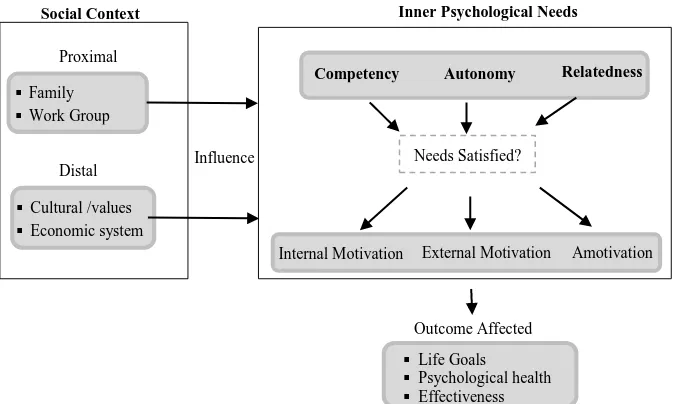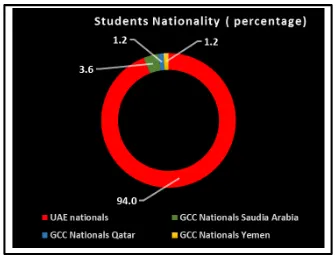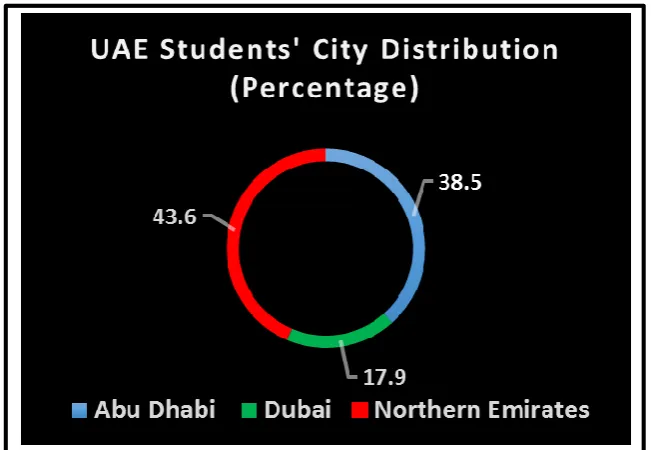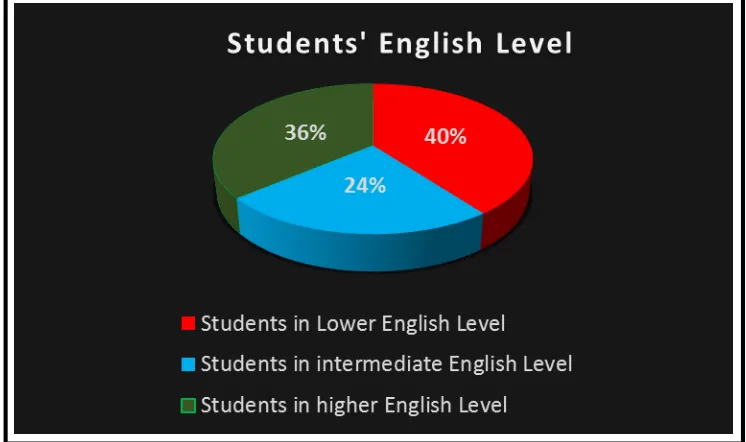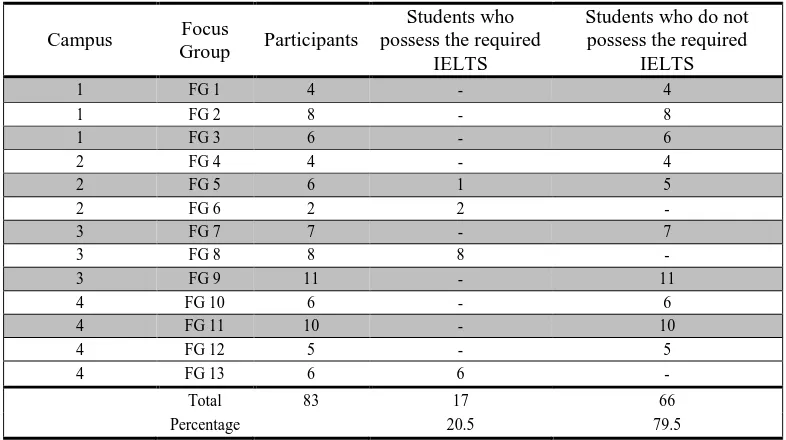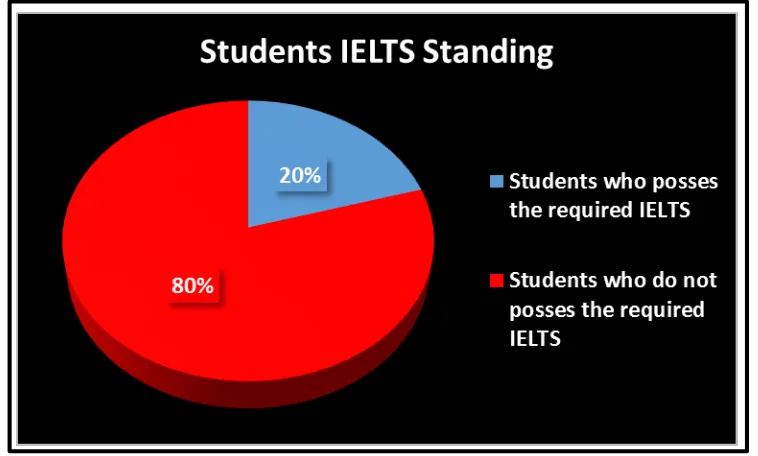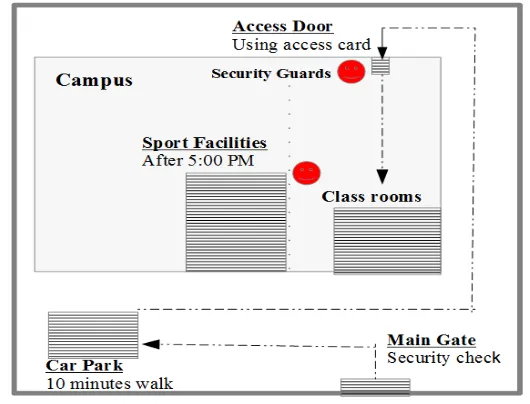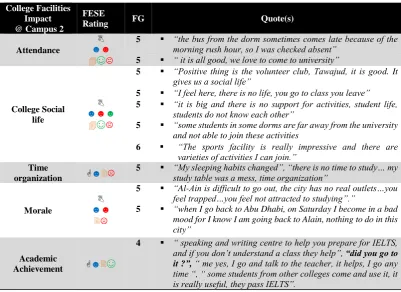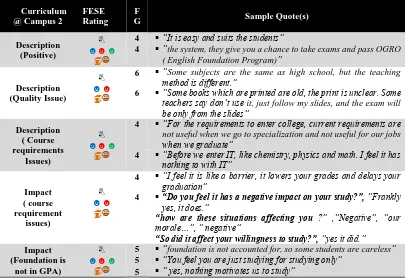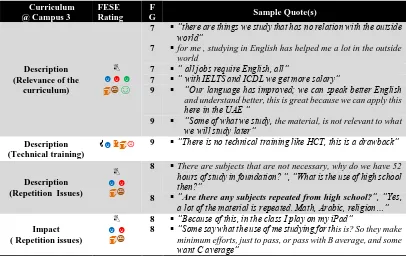i
Determinants that impact first year male students’ motivation
to learn at UAE public colleges
Submitted by
Sultan Ali Rashed Ali Al Kaabi
B.A. in Computer Engineering, M.A in Information Technology
A thesis Submitted in total fulfilment of the requirements for the degree of Doctor of Philosophy
Faculty of Business, Education, Law and Accounting University of Southern Queensland
Toowoomba, QLD Australia
ii
Abstract
UAE male undergraduate dropout is a bleed into the country’s human resources in its strategic quest to enter the digital economy with a well-educated local generation in a post oil-era. The phenomenon is more apparent in first year students studying foundation courses of English to be prepared to enter college.
As students enter the learning environment of higher education institutes, they move from teacher-centric education to learner-centric education, from a predominantly Arab culture of high school, to a predominantly Western environment of colleges where challenges of adaptability arise. In these socially and academically changing education communities, students are expected to assume personal responsibilities in a learner-centric environment utilising different teaching methods and aiding technologies than what they were used to at high school. Inabilities to adapt to this environment have challenging effects on students’ motivation leading to unsatisfactory academic results and even dropouts.
This qualitative descriptive research was conducted using 13 focus groups of first year undergraduate UAE males in the three public UAE colleges of United Arab Emirates University (UAEU), Zayed University (ZU), and Higher Colleges of Technology (HCT). The aim was to understand student perception of their social and education environment and its elements that affect their motivation to learn.
iii
CERTIFICATION OF THESIS
I certify that the ideas, experimental work, results, analyses, software and conclusions reported in this thesis are entirely my own effort, except where otherwise acknowledged. I also certify that the work is original and has not been previously submitted for any other award, except where otherwise acknowledged.
26 Jan 2016 Signature of the Student Date
(Thomas, O’Bannon, & Britt, 2014), (Taylor, 2013), (Reeve, 2008), (Davis Jr, 1986),
(Johnson et al., 2014)
ENDORSEMENT
_____________________ ___________
_____________________ ___________
iv
ACKNOWLEDGMENT
All praise go the lord first, then the Government of the UAE and my family. To my dad and mom, I owe every accomplishment and success in life to your care and sacrifices, you are my light and guide forever. To My wife who was supporting me all the way, I couldn’t have done it without you. To my children whom their dad was travelling all the time, thank you for embracing me after each travel, I hope you loved your gifts!
I would like to thank all my brothers and friends for their support: Saif, Rashed, Subaih, Badr Alshehhi, Imad Alfayomi, Salem Hamdan, Abdulla Alsuraidi, Hasan Omar, Milton Robinson, Ayman, Ali Alabri, Salem AlArimi, Mustafa, Yusif from Ghana, Mohamed from Malaysia, Abu-Bakr, Tariq, Kamal, Abdul Razzaq, Moyassar, Omar Ali, Hashel Alsuraidi, Hamid Alkaabi, Nojoom, Mo Aldhuhori, Anas, Abdulazeez, Khalifa Alshehyari, Anwar, and Khalid Almabrook. To the administrators and students who participated in this study, thank you. To Saud bin Saqr AlQasimi foundation, thank you for your support and help.
To My teacher, Melissa Morgan, who challenged me with her favourite phrase, or song as we students use to call it, ‘so what?’ I say thank you for believing in my abilities and teaching me how to critically think and judge my writing. To My teacher, Abdul Hafez Baig, who taught me that the PhD is a story, my story, with references, I can’t thank you enough for helping me shape my proposal into a very sound piece of art. To Glen, Thank you for the discussions, along with your insights, philosophy, psychological-theory point of views, and most of all your ever supportive friendship, understanding, and the time you invested in supporting my quest. I am for ever in debt to your kindness.
v
Table of Contents
1 Introduction ... 1
1.1 The Setting ... 1
1.2 Research Problem, Purpose, Goal & Question ... 3
1.2.1 Research Problem... 3
1.2.2 Purpose ... 4
1.2.3 Goal ... 4
1.2.4 Research Question ... 4
1.3 Research Motivation ... 5
1.4 Research Scope ... 5
1.5 Research Contribution ... 5
1.5.1 To Theory ... 5
1.5.2 To Practice ... 5
1.6 Key Terms ... 6
1.7 Thesis Organization ... 6
1.8 Summary ... 6
2 Chapter 2: Literature Review ... 9
2.1 Introduction ... 9
2.2 Theoretical Perspective on Motivation ... 9
2.3 The Emotional Dimension ... 11
2.4 Motivation in the Context of this Research... 12
2.5 Conceptual model... 12
2.5.1 Psychological Needs: Self Determination Theory (SDT) ... 13
2.5.2 Unifying Themes in Motivation ... 15
2.5.3 Sources of Motivation ... 17
2.5.4 Expressions of Motivation ... 17
2.5.5 A Framework for Motivation ... 19
vi
2.6.1 Self-Efficacy ... 21
2.6.2 Goal Setting & Goal Striving: Achievement Goal Theory ... 25
2.7 Emotions and Related Motivation Theories ... 27
2.7.1 Cognitive Perspective of Emotions ... 28
2.8 Review of Motivation Research in the UAE ... 29
2.8.1 Social Characteristics Impacting the Student Experience in the UAE . 29 2.8.2 UAE Students’ Social Characteristics ... 29
2.8.3 Characteristics of Public Higher Education in the UAE ... 30
2.8.4 UAE Research on Student Motivation in Higher Education ... 31
2.9 Chapter Summary ... 33
3 Methodology ... 36
3.1 Research Paradigm, Methodology & Method ... 36
3.1.1 Paradigms: Introduction ... 36
3.1.2 Research Ontology and Epistemology ... 37
3.1.3 Research Characteristics ... 38
3.1.4 Research Considerations ... 39
3.1.5 Research Paradigm: Interpretivism ... 40
3.1.6 Research Methodology: Qualitative Descriptive Approach ... 41
3.1.7 Research Method: Focus Groups ... 43
3.2 Instrument & Protocol Design ... 48
3.2.1 Instrument Design ... 48
3.2.2 Protocol Design ... 50
3.3 Role of the Researcher ... 57
3.4 Ethics ... 59
3.4.1 Ethical Concerns ... 59
3.4.2 Ethical Guidelines ... 59
3.5 Data Collection ... 60
3.5.1 Location ... 60
3.5.2 Venue ... 62
3.5.3 Participants ... 63
vii
3.5.5 Layered Focus Groups ... 65
3.5.6 Language ... 66
3.5.7 Time Consideration ... 66
3.6 Data Analysis ... 67
3.6.1 Factors Affecting Analysis Method Choice ... 68
3.6.2 Coding ... 69
3.6.3 Analysis Method: Long Table Approach ... 69
3.6.4 Analysis Steps ... 70
3.7 Trustworthiness of the Results ... 71
3.7.1 Triangulation ... 71
3.7.2 Member Checking ... 72
3.8 Chapter 3 Summary... 72
4 Chapter 4 Introduction ... 75
4.1 Context ... 75
4.2 Themes Presentation Process ... 76
4.2.1 Presentation of Themes ... 76
4.2.2 Symbols Used in Presentation of Themes ... 77
4.3 Findings ... 78
4.3.1 Students’ Background Information ... 78
4.3.2 Summary of Themes ... 86
4.4 Campus Related Themes ... 87
4.4.1 Physical Control Measures ... 87
4.4.2 College Status ... 90
4.4.3 IT Support ... 91
4.4.4 Facilities ... 91
4.5 Curriculum Related Themes ... 96
4.5.1 Curriculum Quality & Fitness for Purpose ... 96
4.5.2 IELTS ... 101
4.5.3 Duration of Study ... 104
4.5.4 Online Environment ... 105
viii
4.5.6 iPad in the Classroom ... 106
4.6 Social Related Themes ... 114
4.6.1 Teacher ... 114
4.6.2 Administration ... 125
4.6.3 Family ... 133
4.6.4 Friends ... 135
4.7 Personal Related Themes ... 139
4.7.1 Social Networks (SN) ... 139
4.7.2 Student Resilience ... 148
4.7.3 Reading ... 148
4.7.4 Goals ... 150
4.7.5 High School Experience ... 151
4.7.6 Study Enjoyment ... 154
4.7.7 Work ... 155
4.8 Chapter Summary ... 157
5 Chapter 5 Introduction ... 160
5.1 Determinants That Impact Motivation: Social Themes ... 161
5.1.1 Instructor Care ... 161
5.1.2 Administration Care ... 166
5.1.3 Family Support ... 170
5.1.4 Friends’ Support ... 172
5.1.5 College Friends ... 172
5.2 Determinants That Impact Motivation: Curriculum Themes ... 177
5.2.1 Quality of Curriculum ... 177
5.2.2 IELTS ... 179
5.2.3 Duration of Study ... 181
5.2.4 Language of Instruction ... 183
5.2.5 iPad ... 183
5.3 Determinants That Impact Motivation: Personal Themes ... 187
5.3.1 Social Networks ... 187
ix
5.3.3 Goal-Setting ... 192
5.3.4 High School Experience ... 194
5.4 Positive and Negative Impact of Determinants on Motivation ... 195
5.4.1 Determinants with Positive Impact on Motivation. ... 195
5.4.2 Determinants with Negative Impact on Motivation ... 196
5.5 Additional / Side Findings ... 203
5.5.1 Side Finding 1: Student Drop out Model ... 203
5.5.2 Side Finding 2: Student Class Failure Model ... 204
5.6 Recommendation... 205
5.7 Contribution ... 206
5.7.1 Contribution to Theory ... 206
5.7.2 Contribution to Practice ... 207
5.8 Limitations ... 208
5.9 Future Research ... 209
5.10 Research Conclusion ... 211
6 References ... 213
7 Appendices... 239
7.1 Appendix 1: Sample of UAE Research in Higher Education ... 240
x
List of Tables
Table 2-1: Expressions of Motivation ... 18
Table 2-2: Efficacy vs. Self-Efficacy vs. Outcome Expectancies ... 21
Table 2-3: Examples of Self-Efficacy Sources ... 22
Table 2-4: Impact of Self-Efficacy on Behaviour ... 23
Table 2-5: Mastery & Performance goals in Approach & Avoidance States ... 26
Table 3-1: Research Characteristics ... 39
Table 3-2: Considerations of Interpretivism & Current Research ... 40
Table 3-3: Interpretivism Paradigm Characteristics ... 41
Table 3-4: Focus Groups vs Observation and Individual Interviews ... 45
Table 3-5: Rationale for Choosing Focus Groups for the Study ... 46
Table 3-6: Group Interview vs Focus Group ... 49
Table 3-7: Protocol Development Strategy ... 50
Table 3-8: Sources of Focus Group Questions ... 51
Table 3-9: Protocol Development Guidelines ... 52
Table 3-10: Protocol Constraints ... 55
Table 3-11: Protocol Constraints Compliance ... 56
Table 3-12: Role of the Researcher ... 57
Table 3-13: Research Ethics ... 60
Table 3-14: Participating Universities' Information ... 61
Table 3-15: Research’s Sampling Process ... 64
Table 3-16: Focus Group Layered Design ... 66
Table 3-17: Participating Universities’ Academic Calendar ... 67
Table 3-18: Focus Group Analysis Characteristics ... 68
Table 4-1: FESE Table Designations ... 78
Table 4-2: Nationalities of Participating Students ... 79
Table 4-3: Participating UAE Students Geographical Distribution ... 81
Table 4-4: Participants Students Work Status ... 82
xi
Table 4-6: Students IELTS Standing; (Campuses1-4) ... 85
Table 4-7: Summary of Generated Themes ... 87
Table 4-8: Description of Physical Control Measures @ Campus 3 ... 88
Table 4-9 : Impact of Physical Control Measures @ Campus 3 ... 89
Table 4-10: Description of College Status @ Campuses 1 & 3 ... 91
Table 4-11: Description of College Facilities and its Impact @ Campus 1 ... 92
Table 4-12: Description of College Facilities @ Campus 2 ... 93
Table 4-13: Impact of College Facilities @ Campus 2 ... 94
Table 4-14: Description of College Facilities and its Impact @ Campus 3 ... 96
Table 4-15: Description of College Facilities & its Impact @ Campus 4 ... 96
Table 4-16: Description & Impact of Curriculum Quality @ Campus 1 ... 97
Table 4-17: Description of Curriculum Quality& its Impact @ Campus 2 ... 98
Table 4-18: Description of Curriculum Quality & its Impact @ Campus 3 ... 99
Table 4-19: Description of Curriculum Quality & its Impact @ Campus 4 ... 100
Table 4-20: Description of IELTS & its Impact @ Campuses 1-4 ... 102
Table 4-21: Description of Study Duration & its Impact @ Campuses 1-4 ... 104
Table 4-22: Description of Online Environment @ Campuses 1-4 ... 105
Table 4-23: Language of Instruction & its Impact @ Campuses 2-3 ... 106
Table 4-24: Description of iPad use & its Impact @ Campus 1 ... 107
Table 4-25: Impact of using iPad @ Campus 1 ... 108
Table 4-26: Description of iPad use @ Campus 2 ... 108
Table 4-27: Impact of using iPad @ Campus 2 ... 109
Table 4-28: Description of iPad use @ Campus 3 ... 111
Table 4-29: Impact of using iPad @ Campus 3 ... 111
Table 4-30: Description of iPad use @ Campus 4 ... 112
Table 4-31: Impact of using iPad @ Campus 4 ... 113
Table 4-32: Teacher Description @ Campus 1 ... 115
Table 4-33: Impact of Teacher @ Campus 1 ... 115
Table 4-34: Teacher Description @ Campus 2 ... 117
Table 4-35: Teacher Impact @ Campus 2 ... 118
xii
Table 4-37: Teacher Impact @ Campus 3 ... 121
Table 4-38: Teacher Description @ Campus 4 ... 123
Table 4-39: Teacher Impact @ Campus 4 ... 123
Table 4-40: Administration Description @ Campus 1 ... 126
Table 4-41: Administration Description @ Campus 2 ... 127
Table 4-42: Old and New Administration Comparison @ Campus 3 ... 129
Table 4-43: Administration Description & Impact @ Campus 3 ... 130
Table 4-44: Administration Description & Impact @ Campus 4 ... 132
Table 4-45: Family Positive Description & Impact @ Campuses 1-4 ... 133
Table 4-46: Family Description with Negative Impact @ Campuses 3-4 ... 134
Table 4-47: College Friends Description & Impact @ Campuses 1-4 ... 136
Table 4-48: Non-College Friends Impact @ Campuses 1-4 ... 138
Table 4-49: Social Networks Description @ Campus 1 ... 140
Table 4-50: Social Networks Impact @ Campus 1 ... 141
Table 4-51: Social Networks Description @ Campus 2 ... 142
Table 4-52: Social Networks Impact @ Campus 2 ... 143
Table 4-53: Social Networks Description@ Campus 3 ... 145
Table 4-54: Social Networks Impact @ Campus 3 ... 145
Table 4-55: Social Networks Description @ Campus 4 ... 146
Table 4-56: Social Networks Impact @ Campus 4 ... 147
Table 4-57: Reading Description & Impact @ Campuses 1-4 ... 149
Table 4-58: Goals Description & Impact@ Campuses 1-4 ... 150
Table 4-59: high school Vs College practices@ Campus 2 ... 151
Table 4-60: Students’ Adaptability issues @ Campus 2 ... 152
Table 4-61: perceptions of High School teachers @ Campuses 2-3 ... 153
Table 4-62: Perceptions on Enjoyment @ Campuses 1& 3 ... 155
Table 4-63: Work Impact @ Campuses 1, 2 & 4 ... 156
Table 5-1: Impact of caring Instructors ... 162
Table 5-2: Impact of uncaring Instructors ... 164
Table 5-3: Impact of Caring Administration ... 167
xiii
Table 5-5: Administration use of Social Networks in College ... 170
Table 5-6: Impact of College Friends ... 172
Table 5-7: Impact of Non-College Friends ... 176
Table 5-8: Impact of Curriculum ... 178
Table 5-9: Impact of IELTS ... 179
Table 5-10: Impact of Duration of Study ... 182
Table 5-11: Impact of iPad ... 184
Table 5-12: iPad Activity Design Process ... 187
Table 5-13: Impact of Social Networks ... 188
Table 5-14: Impact of Work ... 192
Table 5-15: Impact of High School Experience ... 194
Table 5-16: Determinants with Positive Impact on student Motivation ... 195
Table 5-17: Factors students related directly to their Motivation ... 198
Table 5-18: Current Research Motivation Framework ... 199
Table 5-19: Student Self-Comparison vs Friends ... 201
Table 5-20: Factors Students relate directly to Drop out ... 204
xiv
List of Figures
Figure 2-1: SDT Depiction of Human Nature ... 13
Figure 2-2: Context of Social-Determinant Theory ... 14
Figure 2-3: Unifying Themes of Motivation ... 15
Figure 2-4: Sources of Motivation ... 17
Figure 2-5: Motivation Framework ... 19
Figure 2-6: Proposed Research Motivation Framework ... 20
Figure 2-7: Pintrich’s Three Perspectives on Goals ... 25
Figure 3-1: Ontology vs Epistemology. ... 37
Figure 3-2: Research Methodology and Method ... 43
Figure 3-3: Structure of the Focus Group Protocol ... 53
Figure 3-4: Research Protocol Content Excerpt ... 54
Figure 3-5: Participant Universities' Campus Locations ... 62
Figure 3-6: Researcher’s Theme Analysis Path Line ... 70
Figure 4-1. Research's Data Analysis Process. ... 75
Figure 4-2: Themes Presentation Scheme ... 76
Figure 4-3 : Percentage of participating UAE students’ vs GCC students ... 80
Figure 4-4: Focus-Group UAE students' City Distribution ... 82
Figure 4-5: Students Work Status; (Campuses 1-4) ... 83
Figure 4-6: Students English Level; (Campuses 1-4) ... 84
Figure 4-7: Students IELTS Standing (Percentage); (Campuses 1-4) ... 86
Figure 4-8: Physical Control Measures; (Campus 3) ... 88
Figure 4-9: Impact of Physical Control Measures @ Campus 3 ... 90
Figure 4-10: College Facilities Location Map @ Campus 2... 93
Figure 4-11: College Facilities (Impact); Campus 2 ... 95
Figure 4-12: Curriculum Impact @ Campus 2 ... 99
Figure 4-13: Curriculum Impact @ Campus 3 ... 100
xv
Figure 4-15: Description of Study Duration & its Impact @ Campuses 1-4 ... 105
Figure 4-16: Description of iPad use & its Impact @ Campuses 1-4 ... 114
Figure 4-17: Teacher Description & Impact @ Campus 1 ... 116
Figure 4-18: Teacher Description & Impact @ Campus 2 ... 119
Figure 4-19: Teacher (Description & Impact); Campus 3 ... 122
Figure 4-20: Teacher (Description & Impact); Campus 4 ... 124
Figure 4-21: Teacher Impact @ Campuses 1-4 ... 125
Figure 4-22: Administration Description & Impact @ Campus 1 ... 126
Figure 4-23: Administration Description & Impact @ Campus 2 ... 128
Figure 4-24: Administration Description & Impact @ Campus 3 ... 131
Figure 4-25: Administration Description & Impact @ Campus 4 ... 133
Figure 4-26: Family Positive Support @ Campuses 1-4 ... 134
Figure 4-27: Family Negative Support @ Campuses 3-4 ... 135
Figure 4-28: College Friends Description & Impact @ Campuses 1-4 ... 137
Figure 4-29: Non-College Friends Description & Impact @ Campuses 1-4 ... 139
Figure 4-30: Social Networks (Description & Impact) @ Campus 1 ... 142
Figure 4-31: Social Networks Description & Impact @ Campus 2 ... 144
Figure 4-32: Social Networks Description & Impact @ Campus 3 ... 146
Figure 4-33: Social Networks Description & Impact @ Campus 4 ... 148
Figure 4-34: Reading Description & Impact @ Campuses 1-4 ... 149
Figure 4-35: Perceptions of High School Teacher @ Campuses 2-3 ... 154
Figure 4-36: Work Description & Impact @ Campuses 1, 2 & 4 ... 157
Figure 5-1: Inquiry-Based Learning and Affiliated Instructions ... 175
Figure 5-2: Academic use of Social Networks in college ... 191
Figure 5-3: Determinants with Positive Motivation Impact ... 196
Figure 5-4: Determinants with Negative Motivation Impact ... 197
Figure 5-5: Student Drop out Model ... 203
xvi
List of Acronyms
AD: Abu Dhabi
BBM: BlackBerry Messenger (BBM) CBI: Concept Based Instruction (CBI)
FESE: Frequency, Extent, Specificity and Emotion table FG: Focus Group.
GCC: Gulf Cooperation Countries GPA: Grade point Average
HCT: Higher Colleges of Technology.
IELTS: International English Language Test Score.
ISLPR: International Second Language Proficiency Requirements IT: Information Technology
LMS: Learning Management System
MUSIC: eMpowerment, Usefulness, Success, Interest, and Care. RAK: Ras Al-Khaima.
SMS: Short Message System. SMT: Social Media Activity
SSSP: Supplemental Support Study Programme TAM: Technology Acceptance Model
UAE: United Arab Emirates
UAEU: United Arab Emirates University. UAQ: Umm Al-Qaiwain.
US: United States.
USQ: University of Southern Queensland. ZU: Zayed University.
Chapter 1: Introduction
1
1 Introduction
Stagnant enrolments and high dropout rates amongst male students is one of the most significant challenges facing the United Arab Emirates (UAE) as the country strives to realise its vision for a dynamic, world-class higher education system. The government of the UAE seeks to provide all its citizens with a high quality education ("UAE 2021 vision," 2011) but the enrolment numbers for males have been lagging behind female enrolments for more than 20 years (Fox, 2007). Abdulla and Ridge (2011) show that more than 70% of current UAE students in higher education are females while NAPO, the UAE national admission and placement office, reports that the higher education enrolment rate for UAE males declined as low as 23% of total enrolment rates in recent years ("Fourth annual survey of no shows," 2005).
The high attrition rate of UAE male undergraduates compounds the problem. As many as 40% of UAE male undergraduates drop out of college within their first year (Swan, 2012a). The UAE is a small nation, with UAE citizens accounting for only 12% of its 8.3 million population ("Abu Dhabi has over 42% of Emiratis," 2011), and investment in human development is crucial for the country’s future. Therefore, it is important that the issue of males in higher education is better understood. Understanding the factors involved will help facilitate a nurturing environment that will eventually reduce male students’ attrition in UAE higher education.
Previous research in the UAE suggests that the structure of the educational system itself, cultural factors and issues within the colleges themselves make it difficult for male students to adapt and prosper (Engin & McKeown, 2012; Randeree, 2008). Previous studies have also found that students in general in the UAE are not highly motivated, particularly males (Engin & McKeown, 2012). Motivation is clearly a core issue as regards higher education in the UAE but only a very limited amount of research has been conducted on this topic within the country. Although motivation in higher education has been researched relatively extensively in other countries, particularly in the West, the social and cultural milieu in the UAE is so different that this research is tenuously applicable at best.
1.1 The Setting
In an increasingly digitized world of information, education is reforming itself as we are reshaping the way we interact with information and learning. With the arrival of globalization and the transnational economy, countries put educational reforms on the radar screen to help better equip their young generations with the skills needed to enter the global economy (Chan & Mok, 2001; Davies & Guppy, 1997).
Chapter 1: Introduction
2
This evolution is well defined in the country’s 2021 vision initiative. The UAE government promises first rate education built around innovation, research, science and technology. Student achievement is at the core of this vision and preparing students to lead the country into the global digital economy is the ultimate goal of this initiative ("UAE 2021 vision," 2011).
UAE educational bodies such as Ministry of Higher Education and Scientific Research (MOHSER) and Ministry of Education (MOE) are the prime targets of the UAE education vision. In particular, universities are key players in preparing students for the digital economy. Under MOE, the UAE public education is still largely a traditional face-to-face, teacher-centric education system ("Comprehensive new school model," 2009). However, MOHSER has driven the changes in higher education and forced public higher education institutes (PHEI) to re-align their strategies to accomplish the vision ("HBMeU e-learning," 2011).
As the vision’s success depends on proper implementation, UAE PHEI has undergone changes to re-align their strategies to accommodate this ambitious vision. A shift in accreditation requirements has driven these institutes to adopt Learning Management Systems (LMS) and look for more progressive teaching methods. Colleges have either established in-house LMS, or purchased a Blackboard solution to leverage the benefits of active learning for their students ("HBMeU e-learning," 2011). This step was deemed necessary to create a technology assisted educational environment, better known as blended learning (Randeree & Narwani, 2009).
The implementation of blended learning has introduced high levels of change into the system and this brings both benefits and challenges. If the challenges are not addressed properly, the effects of change might exacerbate problems already present in the system. Some educational reform practices within UAE PHEI have already had a major impact on many UAE undergraduate students, increasing rather than decreasing levels of academic failure and doing little to address the high rate of attrition amongst males.
Technology alone is not the solution to the systemic issues in UAE higher education. Research suggests that macro-issues relating to the social environment and the structure of higher education must be addressed before real progress can be made. Examples of these issues include cultural and societal factors that make tertiary study less attractive to male students as well as widespread dissatisfaction with academic support.
Chapter 1: Introduction
3
instructor support has a negative impact on the student learning experience and academic standing.
The high rate of male student attrition should sound alarm bells to educators and encourage them to investigate reasons that lead students to decide to leave higher education. However, instead of looking into the causes of attrition, some UAE PHEI raised the entry bar requirements, filtering out 3,250 students a year who were labelled as ‘low-achieving school leavers’ (Swan, 2012e). Understanding what impacts students’ academic standing in these environments is an issue that has to be addressed (Swan, 2012a).
1.2 Research Problem, Purpose, Goal & Question
Every research project, in its evolution from idea to a study, goes through a development cycle of stating the “topic, problem, purpose, goal, objectives and research question” (Johnson & Christensen, 2012, p. 63). The topic of this research is the lived experience of UAE students in a tertiary education setting and the impact of these lived experiences on their motivation.
1.2.1 Research Problem
Education is important both on a personal and societal level. Personal incentives to pursue education include, but are not limited to, financial stability, equality, satisfaction and social status. On a bigger scale, individuals with education become active members in advancing their societies’ economic growth and wellbeing. Societies also expect their members to go to school and college and become a positive force for advancement on all levels. This is especially important when the population of a society is small, as is the case in the United Arab Emirates (UAE). The UAE is a small, oil-rich nation in the Middle East. Albeit being a small and relatively new country established in 1972, the country has invested its wealth to build a modern, educated society where education forms a core strategy in its quest to advance in the global digital economy.
Chapter 1: Introduction
4
last day of Semester 2 on 7 June 2012” (Hatherley-Greene, 2014, p. 17). This statistic is nothing short of alarming.
Learning is a social activity (Bell, Tzou, Bricker, & Baines, 2013; Jarvis, 2012; Pea, 2004; Pirolli & Kairam, 2013; Richardson & Swan, 2003; Wenger, 1998; Wigfield, Cambria, & Eccles, 2012) in which students participate in different acts of engagement, interactions, choices and persistence over the course of their study. In essence, the rationale behind such behaviour, or the motive to act, is an important topic to be understood, measured and studied because motives impact human behaviour and decisions (Stone, 1997; Wood & Bandura, 1989).
As UAE students enter PHEI, they move from teacher-centric education to learner-centric education where challenges of adaptability arise (Burt, 2004). In active learning, students are socially and academically engaged in the college learning community. An inability to adapt to this environment often has detrimental effects on students, leading to unsatisfactory academic achievement (Schiefele & Csikszentmihalyi, 1995).
Research shows that student motivation tops the list of reasons for student attrition in higher education (Hernandez & Nesman, 2004, p. 464). A scientific approach is needed to understand the factors that influence UAE students, males in particular, to undertake tertiary education and engage in their learning environment. In particular, it is important to examine the influence of the social environment and the structure of tertiary education on student motivation.
1.2.2 Purpose
The purpose of this qualitative descriptive study was to discover motivational and de-motivational factors as encountered by male students in their first year of study at UAE public colleges and the impact of these factors on their motivation. Motivation is a driver of achievement and can be nurtured or suppressed by the surrounding environment and personal experiences. There are many ways to understand student motivation and one of them is to ask students themselves to talk about their motivation in a non-threating environment. Students’ perceptions of their motivation is what matters the most and this area has received little attention within the context of the UAE higher education. It is thus vital to understand what students go through in their first year of college, what experiences they live and how this influences their motivation to continue or opt out.
1.2.3 Goal
To understand the factors that impact undergraduate male student motivation in UAE public colleges.
Chapter 1: Introduction
5
“What is the perception of first-year UAE male undergraduates of the factors that impact their motivation at UAE public higher education institutes?”
1.3 Research Motivation
Motivating learners has been part of the researcher’s job in the UAE government. In his last post, the researcher held the position of deputy director of a governmental institute for management training. Interactions with job trainees and students have enriched the researcher’s personal learning experience. The educational issues of student motivation, learning skills, and academic achievement within the institute are a mirror image of the educational challenges within the larger sphere of the UAE.
A review of UAE educational challenges has revealed a shortage in qualified local researchers in the field. There has been limited educational research in general and even less research on structural deficiencies, motivation in tertiary education and the pernicious problem of male student attrition. The researcher hopes that this study will provide an impetus for further research and, ultimately, policy initiatives that will address current issues. The researcher hopes to seek an academic career in the UAE, to disseminate the knowledge gained from this research, and to create a knowledge community that promotes further research and inspires a new generation of researchers in the field.
1.4 Research Scope
This is a study of first-year male undergraduate students at public higher education institutes in the UAE. The sample was drawn from the student population at the three public colleges of the UAE. This research was not an attempt to study individual participants but the focus was on the collective opinions of groups of students. Also, this research did attempt to observe how students behave in their daily activities at college.
1.5 Research Contribution
1.5.1 To Theory
• To the best knowledge of the researcher, very limited research has been undertaken on undergraduate students’ motivation and social learning experience within UAE higher education. There is a need to fill the void in this body of knowledge.
• This research will also contribute to the valuable and always evolving literature on motivation in general and as it applies to students in higher education in particular.
• A model will be tested in the study. This model will form a basis for further scientific research into motivation in higher education specifically within the UAE and other Gulf countries with similar cultures, for example Saudi Arabia, Oman, Qatar, Bahrain and Kuwait.
Chapter 1: Introduction
6
This research will provide practical insights for those involved in day-to-day teaching in higher education in the UAE.
• The insights and results from this research will assist UAE HEI policy makers to incorporate important stakeholder viewpoints relating to learning experiences within these institutes in their strategic planning. This will help them to align strategies, policies and practices to best serve the interests of the nation in general and students in particular. • The insights from this research will provide educators with potential tools which will allow them to address current issues in the learning environment, pedagogy, curriculum development and course design. They might also be used to introduce intervention programs in order to help students cope with their studies and gain the skills needed for career and academic success.
• The insights from this research will permit policy makers to better understand and potentially address the issues of low levels of male participation accompanied by high attrition rates.
1.6 Key Terms
For the purpose of this study, the following key terms are defined:
UAE Learning Determinants: will be defined as the UAE-specific learning related factors that are related to UAE society, students and learning environment along with known factors related to the social constructivist learning approach (mainly academic caring, self-efficacy and social interactions) that impact a student’s decision to engage or disengage in a society of learning in a blended environment and its implication on academic achievement.
1.7 Thesis Organization
The thesis is organized in the following fashion:
- Chapter 2: Literature Review. Literature related to student motivation and the UAE learning environment is introduced.
- Chapter 3: Research methodology, including the philosophy, methods, instruments and validity and reliability.
- Chapter 4: Qualitative Data analysis and discussion. - Chapter 5: Quantitative Data analysis and discussion - Chapter 6: Research Conclusion.
- Appendices: Research appendices.
1.8 Summary
Chapter 1: Introduction
7
Chapter 1: Introduction
8
Chapter 2: Literature Review
9
2 Chapter 2: Literature Review
2.1 Introduction
This chapter presents an overview of the literature relating to the motivational constructs impacting students’ learning experience in higher education. The chapter also reviews the current standing of UAE literature on student motivation in higher education. These findings are of particular importance to this study as they shape the current quest of exploring student-related determinants that contribute to the understanding of social motivational constructs in UAE higher education.
The organization of the literature review chapter is as follows: an overview of motivation theory; a theoretical perspective focusing on the cognitive approach; the conceptual framework for the study; a review of applicable UAE research; and a chapter summary.
2.2 Theoretical Perspective on Motivation
Motivation can be viewed as the force which provides the impetus for human behaviour, causing individuals to initiate and sustain goal-directed actions (Jenkins & Demaray, 2015). It is related to the person’s will to embrace or get involved in a task or a process of action and serves to explain why individuals pursues some courses of action but avoid others (Schunk, Pintrich, & Meece, 2008; Weiner, 1992). Motivation has been the focus of much research involving many theories and constructs (Wigfield, Eccles, Schiefele, Roeser, & Davis-Kean, 2009). Furthermore, motivation has been studied from multiple scientific perspectives including the cognitive, phenomenological, physiological and cultural dimensions (Ryan, 2012). Research into motivation crosses many disciplinary boundaries, including psychology, education and management.
Given the vast scope of research on motivation and the many theories it has spawned, a broad overview serves as a useful introduction. Furthermore, given that the discipline of psychology spawned research into motivation and continues to be the epicentre of related research activity, an examination of previous research via the prism of several of the major perspectives in psychology provides such an introduction with a strong conceptual foundation.
Chapter 2: Literature Review
10
states. Whereas a wish represents a desired outcome and becomes less intense when that outcome is achieved, a fear represents an undesired outcome and is accompanied by unpleasant feelings (McClelland, 1985).
Experimental research has revealed that there is a strong unconscious element in motivation (Shaver & Mikulincer, 2005). McClelland (1985) argued that conscious motivation is explicit and often focused on concrete, relatively immediate goals whereas unconscious motivation is implicit and is the primary driver of behaviour over time. While explicit motivations do often override implicit motivations in the short term, long-term behaviour is predicated on unconscious motivations. Given that research also suggests a link between child-rearing practices and the power of implicit motivation (McClelland, 1985) and the link between these practices and culture, the psychodynamic perspective would predict significant differences across cultures in the dynamics of motivation.
The behaviourist perspective is not concerned specifically with constructs such as motivation but rather with operant conditioning. This is the simple notion that humans prefer to seek reward and avoid punishment. The theory focuses on drive-reduction, whereby the unfulfilled needs of humans lead to drives towards a state of homeostasis (Weiler, 2005). This drive towards a state of equilibrium is what motivates humans (Cheng & Yeh, 2009). This perspective has a long history in education as witnessed by decades of research into schedules of reward for positive behaviour and punishment for negative behaviour. However, it has fallen out of favour in motivational theory in general and as it applies to education in particular. This is due to the limitations of the perspective in terms of explaining the wide diversity of human behaviour (Cheng & Yeh, 2009) and, in an educational context, its poor explanatory power for many types of learning (Weiler, 2005). The humanistic perspective focuses on the need people have to grow and achieve a sense of personal identity and fulfilment. Maslow’s hierarchy of needs is the dominant theory within this perspective. The theory argues that motivation is driven by unfilled needs which are organised in a hierarchy (Neher, 1991). The hierarchy progresses from lower-level needs to higher-level needs along the continuum: physiological, safety, love and self-esteem. Each level of need must be satisfied to some extent before the next level becomes relevant (Neher, 1991). Thus, many people never reach self-actualisation but are stranded, forever driven and motivated by needs lower down in the hierarchy. The theory has spawned a vast research effort, particularly in industrial psychology, but many questions remain (Neher, 1991). Not only is the theory exceptionally difficult to test and validate but its fundamental premises have been rigorously challenged. Neher (1991), for example, challenged the notion that higher-order needs are innate, pointed out that in many societies the hierarchy does not work as described and argued that the theory, at best, only has limited application in affluent, western societies.
Chapter 2: Literature Review
11
(Trautwein et al., 2012). The cognitive approach views the human mind as analogous to a computer and focuses on information processing as well as decision making (Bandura, 2003; Trautwein et al., 2012). One of the dominant theories within this perspective is expectancy theory, which argues that perceived ability and perceived linkages between effort and achievement are central to motivation and will be discussed in some detail later. Bandura (2003) points out that goals are at the core of cognitive motivational theories, arguing that goals are outcomes desired by the individual that have their roots in social learning.
Goal-setting theory emerged from this focus on goals and has been extensively researched in organisational contexts (Locke, 1991). The focus here is on goals as outcomes that are desirable and deviate from the status quo. Locke (1991) argues that a specific set of conditions must exist before goals are able to motivate performance: goals must be specific and relate to a gap between the current situation and a desired situation; there must be a belief that the goal is attainable and regular feedback on progress is essential; goals must be at least moderately challenging and the individual must be relatively committed to achievement. This theory is directly related to expectancy theory and has found significant support in educational contexts (Latham & Brown, 2006).
In recent decades, an important branch of research within the cognitive perspective has focused on intrinsic versus extrinsic motivation. This research has challenged many of the key principles of the behaviourist approach and uncovered interesting parallels with the psychodynamic approach. Deci, Koestner & Ryan, (1999) challenged the focus of the behaviourists on rewards and punishments. They argued that rewards and punishments may act as extrinsic motivators and result in positive short-term outcomes, even to the extent of motivating people to develop competencies. Nevertheless, the most powerful motivators are those that are intrinsic, where people do things because they wish to do them. Deci et al. (1999) argue that rewards could in fact act as deterrents to performance where people feel that their autonomy is compromised and that the way in which the reward is offered is critical. They proposed self-determination theory which posits that motivation thrives in an environment where three innate needs are supported – competence, autonomy and relatedness. The correspondence to current thinking within the psychodynamic perspective is notable, with a direct link to relatedness and indirect links between self-esteem and competence / autonomy. New developments in self-determination theory further develop the link to the psychodynamic perspective with their focus on implicit motives, or motives that operate almost automatically at a level below that of consciousness
2.3 The Emotional Dimension
Chapter 2: Literature Review
12
with cognitive breadth. Negative affect has a narrowing impact while positive affect has a broadening impact (Gray et al., 1994). In behavioural terms, positive affect tends to elicit approach behaviours while negative affect tends to elicit avoidance behaviours. Therefore, emotion always needs to be taken into account when motivation is researched, particularly when the situation under investigation might elicit powerful emotional reactions.
2.4 Motivation in the Context of this Research
Motivation should not be viewed as a general term but as a complex entity that has spawned many theories and models (Chaudhary, 2014; Rizwan, Tariq, Hassan, & Sultan, 2014). To understand motivation, it is important to study the cause of behaviour and the fluctuations it goes through (Nuttin, 2014). The sheer breadth of the research in this area is so vast that focus is critical in any research project. In the context of this research, student motivation relates to multiple theory-based constructs like interests, goals, self-efficacy and attributes that shape student motivation and impact academic outcomes (Pintrich, 2000). Buehl and Alexander (2009) point out the importance of “self-efficacy, competency beliefs, task value and interest, self-determination and goal orientation” (p. 479) in the study of motivation. The cognitive perspective is not only best suited to this research in terms of its relative theoretical adequacy but also due to the fact that is it less limited cross-culturally than some other perspectives. Furthermore, the links to the psychodynamic theory that are found in some of the theories that will be discussed in more detail provide the research with an even broader and more inclusive theoretical foundation.
The aim of this quest is to explore direct and indirect influences on student motivation and their impact on student experience. The first line of inquiry in understanding motivation is to understand how specific behaviours are formed. Motivation impacts behaviour initiation, direction, strength, and cessation. For example, why do people begin an activity? Why do they continue this activity? Why did they choose this activity over others? Why did they stop the activity? And will they repeat such activity again? Thus, the question of what causes behaviour may appear to be somewhat simplistic but is in fact highly complex. It includes all those elements necessary to understand the role of motivation in nurturing, impacting and explaining ongoing behaviour.
The second line of inquiry in the quest to understand motivation is to understand fluctuations in behavioural intensity. This insight is essential to the knowledge of the different reactions of behavioural activism and passivism within a person on different occasions or between people reacting to the same environmental event. Motivation shapes behaviour (Bahlmann, Aarts, & D'Esposito, 2015), changes over time (Kim, 2015) and waxes and wanes at times (Benedetti, Diefendorff, Gabriel, & Chandler, 2015).
2.5 Conceptual model
Chapter 2: Literature Review
13
inner self and external processes arise from the surrounding environment that initiate human behaviour. Even when narrowing the theoretical scope of the research down to the cognitive perspective combined with some elements of the psychodynamic perspective, it soon becomes clear that the diversity of approaches and theories is such that a conceptual model is required in order to shape and structure the research effort.
Reeve (2008) proposed a conceptual framework for motivation that aligns well with this research. His framework emanates from self-determination theory which focuses on the interaction of inner motivational resources, innate growth characteristics, needs and sociocultural factors as people strive to develop and achieve a state of autonomous self-regulation (Deci & Ryan, 2012c). Given that self-determination theory serves as the philosophical foundation for Reeve’s work and also provides the impetus for one of the core internal components of his motivational model (needs), it is appropriate to review the theory in some detail here.
2.5.1 Psychological Needs: Self Determination Theory (SDT)
Self-determination-theory, in Figure 2-1, depicts human nature as a dynamic agent, which thrives or atrophies according to psychological needs fulfilment, facilitation or deprivation of autonomy, competence and relatedness.
Figure 2-1: SDT Depiction of Human Nature
Source: developed by the researcher with reference to Ryan (2012)
Chapter 2: Literature Review
14
is associated with “personal development and behavioural self-regulation” (Ryan & Deci, 2000, p. 68). This association relates human development to three inner needs that foster self-determination: competence, relatedness and autonomy. The three inner needs not only promote personality development but are also responsible for social integration in which the individual is either engaged or alienated in response to the surrounding social conditions. As such, the theory examines social environments that support human development and those that are antagonistic (Ryan & Deci, 2000).
[image:30.595.111.449.346.548.2]Psychologically, the three inner needs posited by SDT relate directly to personal growth and well-being (Deci & Ryan, 2012a). The core concept is that people are in constant need to feel that they are able to interact with their surroundings in a competent manner, relate to others and are self-regulated towards their goals, lives, and actions. Figure 2-2 provides an overview of the contextual elements of SDT including the three psychological needs.
Figure 2-2: Context of Social-Determinant Theory
Source : Developed by the researcher with reference to Ryan & Deci (2000; 2006)
Figure 2-2 accentuates the connectedness and interdependencies between inner psychological needs, motivation and social environments. Inner psychological needs express themselves as drives towards competency, autonomy and relatedness. It is the social context of family, work, cultural beliefs and economic system which determines the motivational style appropriate to a particular situation. For example, the ideal environment permits intrinsic motivation to flourish in safe and supportive settings that facilitate capacity development and expansion. Extrinsic motivation, which is antagonistic intrinsic towards motivation, is more likely to emerge in environments where autonomy is limited
SDT Theory Context
Inner Psychological Needs
Competency Autonomy Relatedness
Needs Satisfied?
Internal Motivation External Motivation Amotivation
Outcome Affected
Life Goals
Psychological health
Effectiveness
Family
Work Group
Cultural /values
Economic system Proximal
Distal Social Context
Chapter 2: Literature Review
15
and reward / punishment is emphasized. Where individuals do not respond to the social context or their needs are not met, they withdraw from the situation. These individuals are said to be amotivated.
2.5.2 Unifying Themes in Motivation
Reeve (2012, p. 150) views motivation as a “force that energizes and directs people” where direction refers to purpose and goal-orientation while energy refers to “strength, intensity and persistence.” Reeve’s point of departure is the unifying themes underlying the construct of motivation, as depicted in Figure 2-3.
Figure 2-3: Unifying Themes of Motivation Source: (Reeve, 2008, pp. 13-14)
The first of the unifying assumptions is that motivation benefits adaptation (Reeve, 2008). Humans live in an ever changing situations. With these different situations come opportunities and risks. In the face of constant environmental change, people need to preserve their well-being; they need to adapt. Motivation supplies humans with the resources that help them survive in such cases. The state of motivation in response to a particular situation can be both positive and negative, affecting the way people adapt. For example, students who are controlled by instructors, administrators, and parents might feel incapable of inner motivation and give up easily when faced with learning challenges. In contrast, students who are given more autonomy and freedom of choice exhibit more will to initiate inner motivations, set goals, and show more persistence towards difficult learning tasks.
The second assumption is that “motives direct attention and prepare action”(Reeve, 2008, p. 14). For example, a student who is sitting in a dorm might be faced with three environmental events: friends giggling next door, feelings of fatigue, and a loud fire alarm. These three events trigger and give rise to three motives: affiliation that encourages the student to leave the room and ascertain why the friends are giggling; rest that demands the student gets some sleep; and threat that demands the student to run down the stairs to avoid
Benefits adaptation
Motivation
Directs attention / Prepares action
Varies over time / Affects behaviour Types exist
Has an approach / Avoid tendency
Chapter 2: Literature Review
16
the danger. Because the student can follow one action at a time, it is the level of urgency that will decide which motive will direct student action; in this case, because the threat motive has a higher precedence than the other motives, the student ends up exiting the dorm to avoid the threat associated with the sound of the fire alarm.
The third assumption is that motives change with time and impact our continuous behaviour. People have, at any given time, a pool of motives and one can be dominant at some point of time while the others remain dormant, weakened but not gone, waiting for environmental triggers to re-energise them. Consider the former example of the student in the dorm: once the fire alarm is over and the associated conditions cease to exist, the threat motive is no longer dominant. The other two motives of affiliation with friends and sleep move up the hierarchy, and the drive to join friends to discuss what happened takes precedence over the rest motive.
The fourth assumption is that motivation is not a singular entity but a collection of different types. People can be considered as multifarious motivational creatures (Vallerand & Losier, 1999). Consider two workers cutting stones. When asked what they are doing, one answers simply that he is cutting stone while the other mentions that he is building a castle. Two different types of motives lead to the same action, the motive to work, and the motive to achieve a goal. Both men are doing the same job, but the quality of their motivation differs, and thus one is engaged in a routine daily task and the other is more excited because of the more powerful motive he harbours. The former is a type of extrinsic motivation, where the worker is offered money in return for the effort to cut stone, while the other is intrinsically motivated to fulfil an inner goal.
The fifth assumption is that motivation includes approach and avoidance inclinations. People adapt approach behaviour when the outcomes are desired and adapt avoidance behaviour when the outcomes are not desired. Consider the former example of the student in the dorm. The first event of threat, the alarm sound, directed the student to run away from an un-desired outcome. Once the threat was over, the second motive of affiliation directed the student to approach friends in order to achieve the desired outcome of being in a social group.
The sixth assumption is that the study of motivation reveals what people want. Motivation theories show and explain that there are similarities in people, even in different cultures and societies, in their emotions, biological dispositions, and needs. Nevertheless, these theories also point out that people grow their motivational assets through experience and via the surrounding cultural and societal framework. Thus, there are universal motivations but there are also others that are more specific, for example to a particular culture or societal group. Thus, motivation theories when implemented associate which motivations are common to all humanity and which are more specific to particular environments.
Chapter 2: Literature Review
17
example, if students are given more choice and empowerment over their learning, they will exhibit more positive actions and become more engaged in their studies. However, if students are controlled and not allowed freedom of choice, they adopt more negative reactions like dropping out of college.
The eighth and last assumption is that motivation theories are essential to understand motivation. Motivation is an extremely complex construct and there is a wealth of motivation theories that, when utilized correctly, can help researchers understand an issue and then guide the solution to it. Without these theoretical frameworks, the inner workings of motivation would be unfathomable.
2.5.3 Sources of Motivation
Reeve (2008) argues that the sources of motivation include needs, cognitions and emotions, as shown in Figure 2-4.
Figure 2-4: Sources of Motivation Source : Reeve (2008, p. 9).
In Figure 2-4, the interplay of internal motivational forces and the external environment is highlighted. The external events might include characteristics of the task environment, situational constraints and sociocultural factors.
2.5.4 Expressions of Motivation
It is important to know that motivation itself cannot be observed because it is a “private, unobservable, and seemingly mysterious experience” (Reeve, 2008, p. 10). What is being observed or expressed are the behaviours that motivate or guide certain actions. Motivation is measured via direct observation of behaviour in controlled environments or via expressions of motivation such as observable behaviour, engagement, physiological changes and self-reports (Reeve, 2008).
Learning about motivation through observation is similar to lab experiments which scientists conduct in a controlled environment and register the outcome. Given the difficulties associated with this approach, the alternative approach of observing expressions
Internal Motives
Needs Cognitions Emotions
External Events
Motivation
Chapter 2: Literature Review
18
of motivation dominates the research. There are four expressions of motivation: behaviour, engagement, physiology and self-report, as depicted in Error! Reference source not found. below.
Table 2-1: Expressions of Motivation
Behaviour Engagement Physiology Self-
Report
Attention
Effort
Persistence
Choice
Probability of response
Facial Expressions
Bodily Gesture
Behavioural Engagement (attention, effort, persistence)
Emotional engagement (interest, enjoyment, sadness, anger)
Cognitive engagement (deep processing, Strategies (learning strategy, problem-solving strategy)), Self-Regulation.
Voice Self-expressions (expressions of needs, preferences, & desires of the self), participation.
Physiological
reactions Q & A
Source : (Reeve, 2008)
The first expression of motivation is behaviour. There are eight elements in behaviour that represent presence, intensity, and quality of motivation. These are attention, effort, latency, persistence, choice, probability of response, facial expressions and bodily gestures. The presence or lack of these elements indicates weak or intense motives within a person. The second expression of motivation is engagement. The term engagement refers to “a student’s active involvement in a learning activity” (Reeve, 2012, p. 150). Engagement is a multidimensional construct comprising four highly inter-correlated dimensions, as follows:
• Behavioural engagement, relates to the more visible aspects of student engagement, including effort, participation, tenacity and compliance with rules (Reeve, 2008). The eight elements of behavioural engagement are: attention, effort, latency, persistence, choice, probability of response, facial expressions and bodily gestures. The presence or lack of these elements indicates weak or intense motives within a person. While the behaviourally engaged student may be hard-working and compliant, this does not ensure that learning is taking place.
• Cognitive engagement is required before true learning takes place (Reeve, 2008). Essentially, behavioural engagement refers to the quantity of the engagement while cognitive engagement is a more qualitative concept. The cognitively engaged student understands and masters the material while managing the learning process (Reeve, 2008). The focus here is on the intensity and quality of the engagement behaviour, emotion and cognitions. This also includes the monitoring of the self’s expressions of its needs.
Chapter 2: Literature Review
19
• Voice relates to actual participation where the individual expresses opinions, desires, preferences, needs and so on.
The third expression of motivation is physiological reactions. Here, physiological responses are the focus, for example changes in the brain, hormones, heart rate, blood chemistry, and respiratory system. Physiological motivation is beyond the scope of this study.
The last expression of motivation is self-report. In self-report, people talk about their motivation in a participatory fashion when asked. Asking questions, whether survey or open ended questions, is a fast and a good way to retrieve specific behavioural expressions of motivation. Using this mode of motivational inquiry means that the obtained data is reliant on how accurately people describe their behaviour. Therefore, it is important that participants trust the interviewer and feel comfortable and safe sharing their emotions and behavioural experiences.
2.5.5 A Framework for Motivation
The intent of the motivation framework is to connect expressions of motivation to their initiating events and underlying motivational theories. Reeves’ (2008) framework, as shown in Figure 2-5 below, offers the mechanism to express such relationships. Here Reeve lays out the dynamics of the motivational process and the various forces that are in operation.
Figure 2-5: Motivation Framework Source : (Reeve, 2008, p. 22).
In the model, applying motivation theories to triggering conditions of motivation represents a systems flow leading to specific outcomes. As seen before, motivation theories are
Antecedent Conditions
Motive Status
Energizing & Directing
Needs
Cognitions
Emotions
Sense of
Urge to
Behaviour
Engagement
Physiology
Wanting to
Not wanting to
Approach
Avoid
Self-report
Chapter 2: Literature Review
20
practical when they predict accurately the outcome of the antecedent conditions. Conditions in the environment interact with internal states in order to create sense of urgency to act. The motive status is where motivation theories of needs, cognitions and emotions are applied to predict the energy and direction of one’s desire to approach or avoid, want to or not want, which leads to one of the four expressions of motivation. For the purposes of this study, physiology is discounted because of measurement issues.
The derived model shown in Figure 2-6 will drive data collection. It is hypothesized that students are more likely to talk about what they faced that led them to act or behave in a certain way and the effects on their motivations and learning. More specifically, students’ self-reports will provide insights into the antecedent conditions they face, the dynamic interplay of needs, cognitions and emotions that drive them to respond in certain ways and, of greatest importance, their unique responses.
Figure 2-6: Proposed Research Motivation Framework
Source: Developed by the researcher with reference to Reeve (2008, p. 22)
The conceptual framework focuses on cognition, needs and emotion (affect). This framework aligns well with the theoretical impetus towards cognitive explanations without discounting the influence of needs, which have their roots in psychodynamic theory. The influence of emotion on motivation is also acknowledged. The framework proposes that the interplay of antecedent conditions and internal motives will drive approach or avoidance behaviour which in turn results in engagement (or otherwise) at the behavioural, cognitive and emotional levels.
1 Antecedent
Conditions
Motive Status
Energizing & Directing
Needs Cognitions
Emotions
Approach Vs Avoid
Engagement
Students’ Self-Report
Behavioural Engagement
Cognitive Engagement
Emotional Engagement
Chapter 2: Literature Review
21
There are now a significant number of theories of motivation and it is not possible to address all of them in a project of this nature. Given the focus on the interplay of antecedent conditions and internal motivational states and the cultural context of the study, a number of theories of motivation have been selected in terms of their suitability for the study. The first of these, self-determination theory, has already been discussed. Finally, theories of emotion which align with the emotional component of the model will be discussed.
2.6 Cognitive and Social Cognitive Related Motivation Theories
2.6.1 Self-Efficacy
Bandura defines perceived self-efficacy as “people's beliefs about their capabilities to produce designated levels of performance that exercise influence over events that affect their lives” (Bandura, 1994, p. 71). Pajares (1996) argues that we should not look to factors such as knowledge, skill or even track record if we seek to find the source of motivation, but to self-belief. Bandura (1994) points out that self-efficacy fosters a sense of personal control. Individuals who possess high levels of self-efficacy believe that they shape their own destiny. Those who think they can influence important events in their lives are the ones who are able to shape the future to their liking and achieve desired personal and social gains. On the other hand, inability to control one’s important life-events leads to “apprehension, dysfunction, apathy and despair” (Bandura, 2000, p. 16). Bandura points out that a sense of self-efficacy also builds a more positive self-concept, which, in turn, makes people more confident that they are able to master new tasks.
Bandura (1977) labels self-efficacy theory a social-cognitive theory and identifies three critical components of self-efficacy, as presented in Table 2-2: efficacy expectation, outcome expectation and self-efficacy.
Table 2-2: Efficacy vs. Self-Efficacy vs. Outcome Expectancies
Efficacy Self-Efficacy Outcome
Can I do it? Can I do it well? If circumstances change during the task, will I be able to adapt and finish it?
Will what I do work?
Am I able to master 10 pages a day
Will I fully understand the material? If the instructor adds more reading for the exam can I adapt?
Will I be ready for the exam next week
Source : Developed for this research with reference to Bandura (1977)
